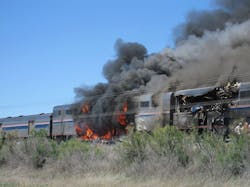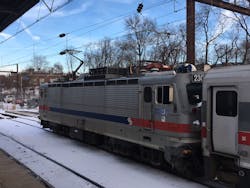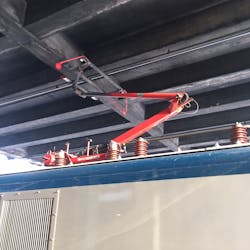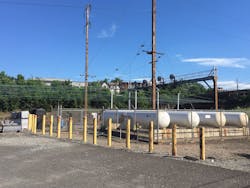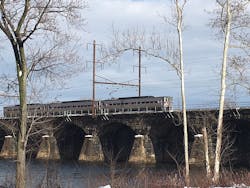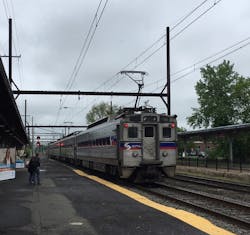Fire departments in urban and metropolitan areas respond to a variety of emergencies involving railways, whether inside the terminal, at the platform, along the tracks or at railroad crossings. We are called to duty for fire alarms, extrications, recoveries, pin jobs, suicides, derailments, hazmat, electrical fires, switch heater and brush fires along the tracks, bomb threats/terrorism, and structure assignments within the station or attached occupancies, such as parking garages and terminal restaurants. But how often do we respond to fires involving passenger trains full of commuters? Are we prepared to handle a burning passenger train car on an elevated platform or an electrical fire in a locomotive carrying 2,000 gallons of diesel fuel?
Rapid transit basics
Although rare occurrences, passenger train fires do happen. They are often started by broken fuel lines spraying on exhaust manifolds, fuel or oil leaks, electrical problems or arson. Most rapid transit fires will involve locomotives, diesel-electric units, passenger cars and the third rail.
Preplans
First-due companies should familiarize themselves with the railroad tracks and train stations in their response area. It helps to know the layout of the terminal, track numbers, standpipe, Fire Department Connections (FDC), Knox-Box locations and railroad crossings.
It’s critical that firefighters familiarize themselves with the electrocution hazards of high-voltage overhead catenary lines, electrified third rails, diesel-electric locomotives, diesel-multiple units and transformers on railway property in electrified territory. Knowing what trains service those tracks (Amtrak, Transit, CSX) can be helpful when it comes to stopping train movement. Further, preplans with railroad emergency management will determine proper agency notifications, which will be helpful when implementing a unified command system during an incident.
Response
During these incidents, company officers should have their dispatcher contact the Transit Police assigned to that jurisdiction or railroad, and meet them on arrival at the station or track location if possible. They are usually familiar with and have access to secured properties along the railroad and in the terminal. They also have their own dispatch and railway contacts if train service must be stopped or power removed. Many of these command centers are miles away and can stop trains and remove power along certain sections of track. Keep in mind this can take several minutes to accomplish. Make contact with the train conductor and engineer, as they can provide important guidance and information on the incident.
Before implementing suppression tactics, first attempt to identify the type of railroad territory and train propulsion, ensure proper apparatus placement, and conduct an initial size-up. This will set the stage for the incident action plan.
Apparatus placement
For train fires occurring in the station at the platform, configuration of the terminal will determine if it's better to supply the FDC or stretch from the pumper. Train platforms can be as long as 1,000 feet with no standpipe connections available on an outdoor platform. The train station in my district has platforms of 600 and 900 feet long. It’s an additional 100 feet up the stairs to reach the closest standpipe inside the terminal.
During fire preplans, measure the distance from the standpipe to the end of the platform or the farthest train car from the outlet. Most high-rise packs alone won’t do the job for this platform, so prepare in advance for long hose stretches.
For elevated platforms, aerials or tower ladders should have priority and be positioned at the ready in case passengers need to be rescued. Although a rare occurrence and usually a last resort, aerial and tower trucks have been utilized to rescue passengers on elevated platforms in the past.
In difficult-to-access areas where terrain will be an issue, you can utilize a smaller apparatus, such as a brush unit, or walk a supply line to the area. For small brush fires along the tracks caused by sparks or arcing, bring a shovel and smother with dirt. If this is not possible, let the railroad handle it.
For railroad crossings, common sense applies: Do not park on or too close to the tracks or under trolley lines.
Size-up
For passenger train fires, the key size-up factors that will determine your strategy and tactics are the location of the fire, access to the train, exposure issues, type of propulsion power and what’s burning (Class A, B, C, all the above). These will be major factors when implementing your initial actions for rescue, fire attack and exposure protection.
Consider the differences between a train fire at the platform in the terminal and a train fire in a tunnel or on a bridge over water. Access can also be a major problem for firefighters, as the railroads are heavily secured properties. Many rapid transit properties are fenced in with locked access gates, fortified fencing, waterways, terrain and other natural barriers that can make it extremely difficult to reach an emergency scene.
Once location has been identified, determine the following:
· What’s on fire (passenger car, locomotive, Class A, B, C)?
· Are passengers trapped in the train cars?
· Is it possible to safely reach the involved train car with a hoseline?
· Is there an FDC and standpipe? If so, is that the best option for attack?
· Are there exposure issues, such as overhead catenary wires or adjacent train cars?
· Are there flammable liquids involved?
· Are there obstruction issues for accessing the train car?
· What is energized and who do we contact to remove power and halt train movement?
For train fires in tunnels:
· What’s burning (third rail, locomotive, passenger car)?
· Are there cross passageways available?
· Is there a ventilation system and is it working properly?
· Is the railway shut down?
Some of these questions can be answered during preplans.
There's no textbook strategy for all train fires. The propulsion power must be identified for the safety of firefighters and passengers because each type has its own dangers and safety procedures to manage before suppression begins. Most rapid transit fires are going to involve electricity. Others will involve flammable liquids and passenger compartment combustibles. Train fires can be Class A, B, C or all the above.
Common propulsion power
Catenary system: A catenary is a system of overhead wires used to supply electricity to an electric locomotive equipped with a pantograph. These high-speed rail lines average 18–23 feet in height from the rail head and are energized with 12,000 volts alternating current (AC). (Note: Trolley lines are overhead lines and poles used to power street cars and light rail.)
Locomotive power: Locomotives used for rapid transit are usually electric or diesel-electric (dual locomotives).
Electric: The standalone electric locomotives use catenary, trolley line or third rail for power.
Diesel-electric: Dual locomotives are operable with or without overhead catenary and pantograph. The diesel engine drives a generator, which makes electricity to power traction motors. These locomotives will have emergency fuel shutoffs on both sides and in the control car and usually carry between 1,000–4,000 gallons of diesel fuel. Most locomotives weigh between 100–125 tons.
Third rail: This is a method of providing electric power to a railway train through a semi-continuous rigid conductor placed alongside or between the rails of a railroad track. Third rails are usually 600–750 volts direct current (DC) electricity with many sporting protective covers on them. Third rails may be top running (the shoes of the train riding on top), bottom running (the shoes ride the underside of the rail) or side running (shoes run along the side of the rail).
Diesel-electric multiple units (DEMUs): DEMUs in light rail use a diesel engine located in the middle car that drives an alternator producing AC to power the electric traction motors in the wheels. Rapid transit light rail service using DEMUs do not always have to rely on electrified territory for travel. This would mean that some of the hazards from overhead catenary wires and the third rail may be eliminated. Again, this is why it’s important to know the propulsion, territory and the trains servicing the tracks in your response area.
Suppression tactics
Typically, when a passenger train catches fire, the engineer will move passengers to the unaffected area of the train or attempt to make it to the next station platform or other safe area to evacuate passengers. But if the train is disabled or stranded in a tunnel, subway or on a bridge, a rescue train will be summoned to transfer and transport passengers. This will also require additional resources from the fire department if there’s no time to wait for the rescue train.
Light rail: Light rail trains are usually powered by overhead catenary, trolley lines, third rail or DEMUs. Most light rail trains also have roof-mounted compressor heating and air conditioner units that can overheat and burn. After determining what is burning, ensure that the train is de-energized and movement stopped with the operator. Fires in locomotives and motor compartments involving diesel fuel should be fought as a Class B fire using foam. Fire extinguishers are usually located in each coach and can be used for small fires in the control car or heating/air conditioning units. Passenger cars are Class A materials and using water is acceptable, as long as the rail, trolley line or DEMUs power is shutoff.
Emergency fuel shutoffs are marked in red and located on both sides of the diesel locomotive exterior and inside the control car. Holding the shutoff for 3–6 seconds will shut down the engine and stop electrical power generation in a diesel-electric locomotive.
Locomotives: For burning locomotives, expect an electrical or diesel fire. With high voltage cabinets and a few thousand gallons of diesel fuel present, you could have both a Class B and C fire. Most rapid transit locomotives are powered by electric, or diesel-electric locomotives that carry up to 5,000 gallons of diesel fuel.
Some locomotives may have an on-board automatic fire suppression system. For instance, the Amtrak Acela has an on-board automatic suppression system that activates 2 minutes after the initial fire alarm is received. The engineer can also manually activate the system right away or acknowledge there’s no fire present and deactivate the system from the control car before suppression agents discharge. These dry chemical agents will discharge in the electrical compartments and equipment rooms. In addition, a dry pipe system is present on the exterior with standard 2½-inch female connection to supply sprinkler heads inside the equipment room.
Passenger Cars: Most passenger cars will involve Class A combustibles. Although not considered “rapid” transit, passenger trains with dining cars (kitchens), sleeping cars (bedroom furnishings) and auto train (several motor vehicles on board) will present potential Class B, C and D fires.
For large Class B fires involving diesel fuel, foam is the best extinguishing agent. This will be common at railroad crossing collisions when locomotive diesel tanks are ruptured from impact or the gas tank of the vehicle being struck by the train ruptures. This type of incident is one of the most common for flammable liquid fires involving rapid transit. If the locomotive is traveling in electrified territory, use extreme caution and de-energize before suppression. Stop train movement in one or both directions on adjacent tracks if needed.
Train fires in electrified territory
Electrified territory is dangerous because of the potential for electrocution. Even after power removal, be cognizant that residual current may be an issue. Most trains are powered by overhead catenary wires or third-rail service. Catenary lines carry 12,000 volts of AC electrical power, with the majority of third rails using between 600–750 volts DC to propel trains. Transmission lines above trolley/catenary lines can have approximately 100,000–200,000 volts present. Switch heaters along the tracks carry 220 volts AC. Firefighters must understand that rushing in to a scene can be dangerous. Wait for the arrival of a railway representative (trainmaster, engineer, electrician, road foreman, lineman, emergency management representative) before approaching a fire in electrified territory.
If the train is derailed and on fire, do not come within 20 feet of the overhead wires or train cars until power has been removed, catenary lines are grounded and permission has been granted by a qualified railroad representative.
Train fires under catenary system: Monitor the overhead catenary wires if exposed to fire, and keep first responders and onlookers away in case they drop. Look for the conductor and engineer for status update, and request them to drop the pantograph if present. Await confirmation that AC power has been secure, and travel is halted on adjacent tracks in both directions of the involved train if they will pose a danger to passengers or firefighters.
Never stretch a line onto a passenger train until you get confirmation from the conductor and engineer that the train’s movement and power is secure.
For a Class A fire inside of a passenger car with no exposure to the overhead catenary wires, or if there’s a life hazard present, a line can be stretched onto the train if the pantograph is dropped first. This will remove it from contacting the high-voltage catenary wires above. The pantograph can be lowered by the engineer with a switch located in the operating cab. Remember, it’s best to work with representatives of the railway on fire attack strategy if possible.
Fires involving third-rail territory: For fires involving arcing third rails, locomotive or passenger cars, the main concern is the danger of electrocution. There's more than enough DC present to kill a complacent firefighter contacting the third rail.
For a Class A fire inside the passenger car, use caution while accessing the car and with water streams around an energized third rail. If there's no life hazard, it's best to just wait for employees of the railway to shut off power before suppression begins.
For electrical fires involving the third rail, consult with a representative from the railroad. It’s best to keep personnel away and wait for the power to be removed (breaker shut off). De-energizing the DC circuit breakers that supply the traction power for the third rails should be done first for safety unless there's a rescue that must take place and a risk/benefit analysis completed. If the fire or rescue is remote from the affected third rail, use extreme caution and do not contact the rail.
Assign a safety officer: The railroad is an extremely dangerous zone, so all train fires should require a mandatory safety officer. In addition to electrocution dangers, there’s the potential of being struck by a train going by at speeds up to 100 mph. Assign a safety officer to monitor approaching trains and alert personnel working in the area. Keep in mind that on high-speed rail, it could take a train up to 2 miles to come to a complete stop once they’re notified by dispatch.
At a fire incident in the Washington, DC, subway, firefighters were surprised when the power that was originally turned off came back on and trains started moving again while operating at a small fire. This could have been disastrous!
Additionally, do NOT walk between or under the cars with the Head End Power (HEP) cables, which are 480 volts of AC power. These HEP cables (pigtails, jumpers) provide power to the passenger train cars where it is reduced to 220 and 110 AC. The current travels through cables underneath passenger cars. Do not remove or disconnect these cables. This is the responsibility of the railroad, not the fire department.
Adjacent and secured properties
Propane: Propane tanks along the railroad are used to fuel switch heaters, which keep track switches from freezing during cold weather. In urban areas, these areas can be accessed by vagrants, vandals and juveniles, possibly for dumping furniture, trash and stolen cars. When responding to trash and vehicle fires along the tracks, request police and use extreme caution on approach for fires where tanks are exposed.
If there’s a propane release along the tracks, train movement should be halted. Propane is heavier than air, and if it reaches the tracks, sparks from a train can be an ignition source.
Substations and transformers: For fires involving substations, request power shutdown and await arrival of a rail representative. Do not attempt entry or extinguishment without consulting with a supervisor from the railroad. Many of these power structures (substations) operate with high voltage and many have an automatic suppression system.
If the fire department is dispatched to railroad property for a transformer fire, request and await a railway representative and protect any nearby combustibles from fire. If there’s no immediate life hazard, wait for the railway representative.
For fires in rail yards, a yardmaster may be on scene to assist.
Bridges over water
Passenger car: For fires in passenger cars separated from the unaffected locomotive, the passengers will most likely be moved to the rear of another car away from the fire, and the train will continue to a safe area for evacuation.
For extreme emergencies, such as derailments or collisions resulting in fire and entrapment, firefighters may have to perform rapid passenger rescues and evacuation from a commuter train. Whether dealing with unbreakable polycarbonate windows, emergency release handle locations, force entry techniques for biparting doors, or activating cantilevered top escape hatches, training with local transit emergency management should help prepare first responders locate and operate these access/egress points.
Locomotive: If the locomotive is burning and disabled, the train will not be able to continue to a safe area to evacuate passengers. It is ideal for the passenger cars to be separated from the locomotive, so the passengers can be safely moved to the rear of the train away from the isolated burning locomotive. A rescue car will likely be requested.
Light rail: If the fire involves a light rail with a connected multiple unit in between the passenger cars, it will be a more serious issue, as the passengers may be forced to leave the car. Hopefully for them, there’s a walkway present along the tracks.
These scenarios will require additional alarms to assist with evacuation. Any time a train is burning over water, marine units should be requested for the potential of panicking jumpers. Depending on location and terrain, lines may have to be stretched down the tracks. Do NOT commit firefighters on a bridge until all train movement in both directions is stopped and rail de-energized.
Elevated platform
A train fire on an elevated platform can be complicated, especially over water and out of reach by aerial apparatus. If it’s just the third rail arcing or an insulator burning, it’s usually a minor issue with passengers sheltering in place until power is shut down.
Evacuating a burning mass-transit passenger train on an elevated platform or bridge is usually a last resort, but that doesn’t mean we shouldn’t prepare for such an incident. Initial actions by the fire department will depend on location, access, propulsion, territory and whether the fire involves the locomotive or passenger car. It helps to contact the conductor and engineer for assistance. The train crew will usually determine the best actions depending on circumstances. They will also help contact their central dispatch to stop movement on any adjacent tracks, and remove power to the train. Options will vary from moving passengers the farthest away from the affected car to evacuating passengers off the right-of-way. Using rescue trains is another option, depending on the urgency to evacuate passengers.
On-board fire extinguishers may help extinguish or keep the fire in check. If not, prepare for additional resources to assist in reaching and evacuating passengers, aerial/tower operations, water supply and EMS. And don’t forget to consider the possibility of elderly and handicapped passengers who may be stranded. Are we prepared for an incident like this?
Monorails: Elevated platform monorail systems are like light rail trains, but operate on a single rail. They also can operate with or without an operator. They are becoming more common at airports, amusement parks, commuter cities and tourist areas, like Seattle, Las Vegas, Jacksonville and Disney properties. Fires in monorails are extremely rare. Like any elevated railway, evacuation of trapped passengers in a burning train will have to be accomplished through adjacent tracks, tunnel exits, rescue cars, walkways or fire department aerial devices.
Again, never commit personnel to a bridge or tunnel without 100 percent confirmation that movement is stopped. Many of these areas are so tight that there’s no room for refuge on either side of the track(s).
Subways and tunnels
Fires in subways and tunnels are often the result of third-rail arcing, or burning dirty insulators that create a smoke condition within the tunnel. The insulators eventually fail and arc, releasing smoke and fire. If the burning insulator is made of fiberglass or porcelain, it can ignite nearby combustibles like wooden rail ties, cables, trash piles and third-rail protective guards. Most of these incidents are minor, but they do have the potential for a mass-causality incident. Although fatalities are rare, smoke inhalation, panic and fall injuries are more common.
Some main concerns for fire operations underground will be radio communications, visibility, commuter panic, air supply, lighting, and manpower. Request air units, hazmat teams for air monitoring, and medical/triage areas for additional resources.
In January 2015, an electrical fire filled the Washington, DC, Metro tunnel with smoke near L’Enfant Plaza, killing one passenger and injuring others. The toxic smoke was produced by insulation in cables called “jumper cables.” At many places in the rail system, gaps in the third rails use jumper cables to ensure that 750 volts of current flow through the third rails, providing power to trains.
If a passenger train is disabled in the tunnel, additional resources will be required immediately for evacuation, equipment transport and suppression. More serious incidents involve a burning locomotive or passenger car with mechanical failure in the tube. A disabled burning train full of commuters producing toxic smoke in a confined space can have deadly consequences.
During fire conditions, the conductor and engineer will attempt to move passengers away from the affected car and to a safe area. If that's not possible due to a risky or dangerous environment or mechanical failure, the passengers must evacuate or shelter in place inside of the tunnel. If there’s an emergency that requires evacuation from the train cars, most tunnels include emergency escape shelters, crossover doors and exit stairs along with ventilation systems. But these options are not always reliable or effective. Hopefully for the confused and panicking passengers looking to escape the tunnel, these protective systems are in place and working to our benefit.
VIDEO: Raw video from inside a smoke-filled DC Metro train stuck at L'Enfant Plaza.
According to NFPA 130: Standard for Fixed Guideway and Transit Systems, the maximum distance permitted between exits and cross passageways is 2,500 feet and 800 feet, respectively. NFPA 130 also requires that an enclosed tunnel of 200 feet or longer be provided with an emergency ventilation system to maintain a tenable environment along the egress path.
Most tubes with smoke control are longitudinally ventilated using mechanical ventilation (supply/exhaust) operated at a remote control center that could be miles away. Other systems are designed to ventilate relying on natural air currents or piston effect (train movement) to exhaust fumes up and out at street level, or in direction of tunnel axis. The idea is to have the smoke pushed toward the direction of travel while passengers move in the opposite direction. This seems like a great plan, but realistically, are we expected to believe 150 passengers fleeing smoke in a tunnel will all comply? This will also pose a problem for firefighters responding from the exhaust direction. Add commuter chaos, limited air supply, poor communications with portable radios, and limited visibility to the list of challenges for first responders.
Rapid transit properties with underground tunnels require extensive preplanning. Some subways may go several levels below grade. A well-involved train car burning in a sub-division will require additional alarms, mainly to assist passengers, and for equipment transport (lighting, SCBA bottles).
For fires in tunnels less than 200 feet long, the main concern is overhead catenary wires that travel through the tunnels exposed to fire from a burning train below. Do not enter any tunnel during a fire with overhead catenary wires exposed until de-energized and grounded by rail employees.
Fires in underwater tubes must have alternate types of emergency exits and egress routes. Again, this emergency evacuation would be a last resort option. Transporting passengers via rescue train is a much safer option.
Railroad crossings
Fires at railroad crossings are usually the result of “train into vehicle.” The vehicle is often ignited by the impact rupturing the gas tank, with sparks produced by the still-moving train as the ignition source. These tragedies usually result in a recovery, with the vehicle being pushed to the side or down the tracks a way before the train comes to a halt. With the vehicle being a total loss, exposure to the train will be the concern for firefighters. These fires have resulted in fire spreading to the control and passenger cars.
Brush fires along the tracks are common because of sparks generated by moving trains igniting the dry brush along the tracks. These can easily be handled with a water can, shovel and dirt, or booster line. The main concern for these small fires are moving trains near firefighters who are not paying attention to their surroundings.
Remember, apparatus placement is a serious priority at a rail crossing. Parking on or too close to the tracks is bad practice.
Final thoughts
It’s important for new firefighters and company officers assigned to an area with rail service to become familiar with railroad crossings, platform numbers, terminal configuration, fire protection systems, bridges, tunnels, elevated platforms, propulsion power, access to secure and adjacent properties. Know the trains that service those tracks and the contact information for transit police, emergency management and dispatchers. Know who to contact for mutual aid, hazmat and foam task force response. Understand the various dangers the railroad presents when responding to fires on railway property. The more information obtained during preplans, the easier your high-risk/low-frequency event will become. Stay safe!
References
Luo, M. “Mistakes During Subway Fire Spur New Emergency Training.” The New York Times. May 1, 2004. www.nytimes.com/2004/05/01/nyregion/mistakes-during-a-subway-fire-spur-new-emergency-training.html.
Sanches, R. and Brumfield, B. “6 killed when train hits SUV in New York.” CNN. www.cnn.com/2015/02/04/us/new-york-train-collision/index.html.
Statter, D. “DC’s subway system surprises firefighters by turning on third rail power during fire incident.” Oct. 16, 2015. www.statter911.com/2015/10/16/dcs-subway-system-surprises-firefighters-by-turning-on-third-rail-power-during-fire-incident.
About the Author
Brian Butler
Brian Butler is a fire captain in the city of Trenton, NJ, where he has worked for 21 years. He is a member of King of Prussia, PA, Fire Rescue in suburban Philadelphia. Butler serves as a rescue/hazmat technician with the Southeastern (Montgomery County, PA) Regional Technical Rescue Task Force and the Bucks County, PA, Hazmat Response Team, and is a level 2 fire instructor. He is the
